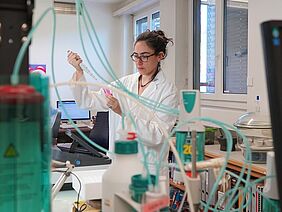Soil quality is normally assessed based on characteristics such as nutrient content, humus content and aggregate structure. "However, one crucial bit of information had so far been missing and that is the quantity and activity of microorganisms such as fungi, algae, bacteria and worms. These are indispensable for many functions of a healthy soil," says Giulia Bongiorno, a former FiBL PhD student who currently works as a research scientist at Wageningen University in the Netherlands. Using soil samples from all over Europe, she was able to show in her doctoral thesis how different agricultural practices impact the activity and diversity of the microscopically small helpers that reside in the soil. Moreover, using the latest statistical methods she determined the significance of different types of carbon. This is important because a particular type of carbon, i.e. labile soil carbon, positively influences the quantity of soil micro-organisms. These, in turn, strengthen numerous soil functions such as disease resistance, aggregate structure, mineralisation and nutrient recycling.
Reduced tillage fosters labile soil carbon and, in turn, soil life
Giulia Bongiorno’s research data show that reduced tillage positively impacts the proportion of this important labile carbon. Moreover, microorganisms were 37 per cent more active, more diverse and showed a greater ability to suppress plant diseases. "However, we are not yet able to answer the question as to the ideal level of microorganisms and worms. We do not have the requisite data and reference values to do that,” says Giulia Bongiorno. “When we get there we can offer the new tests to farmers with a view to improving soils."
Further information
Contact
Paul Mäder
Links
- fibl.org: Activity report
- fibl.org: Projekt Interaktive Bodenqualitätsbewertung iSQAPER (German only)




